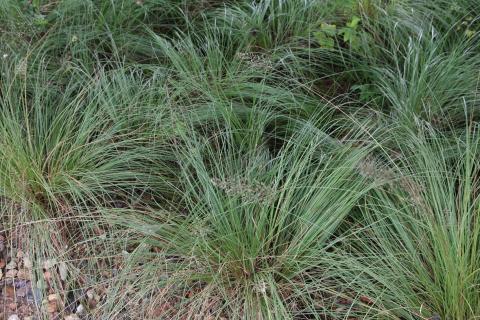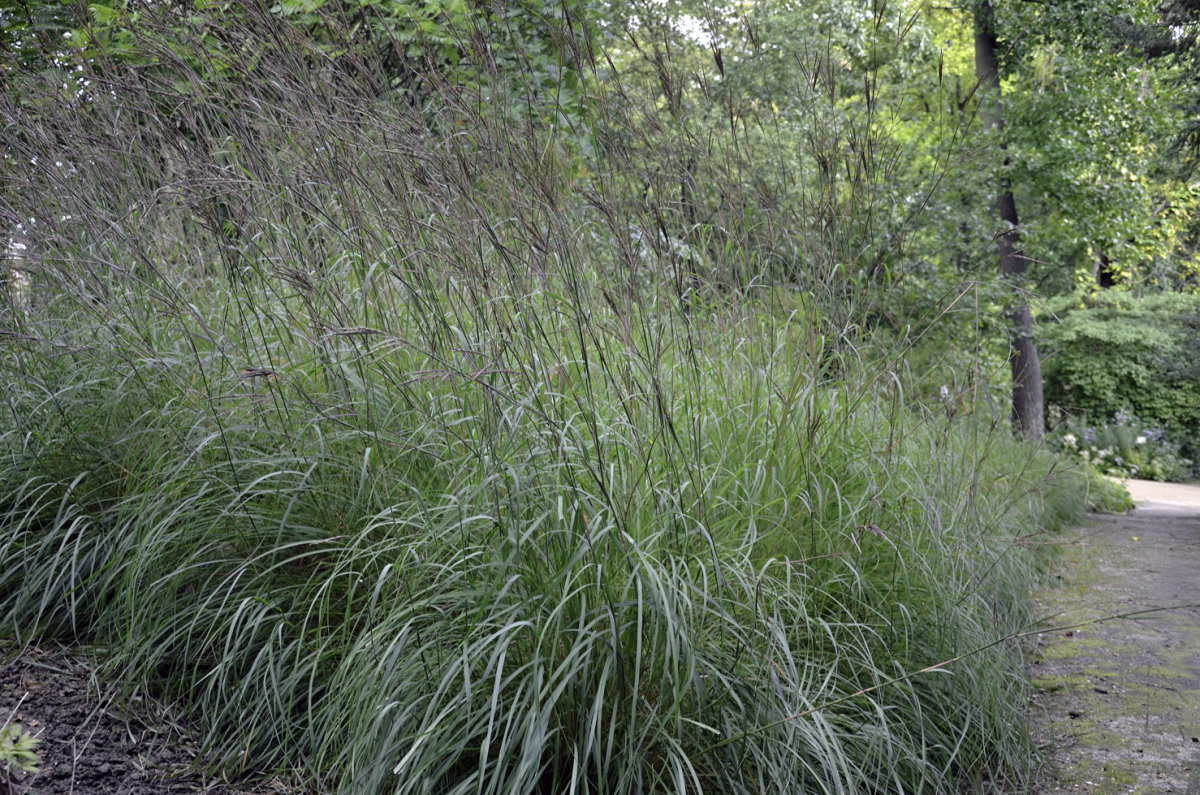What are some of the best native ornamental grasses for landscapes?

Ornamental grasses can make a great addition to the landscape. They are easy to care for and add interesting colors, textures and movement to perennial borders, rain gardens and naturalized areas. Native grass species have the added benefit of being very cold hardy and otherwise well-adapted to the climate of New Hampshire.
All the commonly planted species are perennial warm season grasses, meaning they grow rapidly in the spring and summer, bloom in late summer or fall and go dormant through the winter. In general, native grasses are highly adaptable and can be grown in almost any full sun location with well-drained soil. Consider some of the following species for New Hampshire landscapes.
Native Ornamental Grass Selections for New Hampshire Landscapes
Big bluestem (Andropogon gerardii) grows extensively throughout New Hampshire in floodplains, meadows, fields, woodlands and along the shorelines of rivers, lakes and ponds. It is equally suited to dry, infertile soils and rich, moist soils, though it may topple over in the latter. Big bluestem grows in clumps that reach heights of four to six feet.
Its foliage changes hues as the season progresses, starting off blue green in the spring, taking on reddish tones in summer, and turning red bronze in fall. Tall flower spikes are divided into three parts and colored purplish-red in late summer. Big bluestem is a little too wild to be suitable for formal perennial borders, but it can thrive in wildflower meadows, natural areas and erosion-prone slopes.

Indiangrass (Sorghastrum nutans) is another New Hampshire native that can be found growing throughout North America. It does particularly well in dry, infertile soils, though it is tolerant of almost any well-drained soil in full sun. Indiangrass usually grows between three to five feet tall in clumps of upright stems. In late summer flowering stems topped with feathery flower panicles add two to three feet of additional height to plants. The flower panicles are quite showy and will usually persist through the winter and provide natural forage for songbirds. Indiangrass can be used in wildflower meadows, naturalized areas, on slopes for erosion control or as an accent in perennial borders.
.jpg)
Little bluestem (Schizachyrium scoparium) is very common in New Hampshire and can be found growing in meadows, woodlands, wetland margins and along roadsides. It is also a major component of tallgrass prairies in other regions of the United States. It is often used in landscapes for its upright growth habit and excellent bronze fall color.
Little bluestem grows about two to four feet tall and one to two feet wide. It can be planted successfully in full sun locations with dry to medium moisture and can tolerate drought and occasional flooding. It is also largely ignored by deer and rabbits, lending itself nicely to urban and rural landscapes alike. Little bluestem can be used in a variety landscape situations including perennial borders, rain gardens, naturalized areas and meadows.

Prairie dropseed (Sporobolus heterolepsis) is common in the Great Plains and Midwest. Though its native range doesn’t extend into New Hampshire, this clump-forming species is hardy to Zone 3 and is easy to grow in average to dry soils in full sun. It actually grows best in dry, rocky soils and has very good drought tolerance. Prairie dropseed has very fine-textured foliage that gives it an almost hair-like appearance. In late summer brownish-pink flower panicles rise above the foliage, and drop seeds to the ground in the fall, giving the grass its common name. Prairie dropseed is slow growing and stays fairly compact at about two feet tall by two feet wide. Consider using it as a groundcover in hot, dry areas, as an accent plant or in rain gardens.

Purple lovegrass (Eragrostis spectabilis) is the species that catches the eye along highways in late summer with its reddish-purple flowers. It grows wild in New Hampshire in disturbed areas, meadows and fields, and is often planted on embankments to limit erosion. It can also be integrated into sunny landscapes with dry, sandy soil. In fact, purple lovegrass grows best in locations that are hot and dry with infertile soil.
The foliage of this plant isn’t especially remarkable and usually doesn’t exceed a foot tall and wide. It is easy to overlook until the airy reddish-purple flowers appear in late summer and add an extra foot of height to plants. Look to plant purple lovegrass in masses in perennial borders, naturalized areas and meadows.

Switch grass (Panicum virgatum) is a New Hampshire native species that is easy to grow in average to wet soils in full sun to part shade. Though it performs best in consistently moist, sandy soils, it can tolerate dry soil and drought. Switch grass grows in clumps and gradually spreads by creeping rhizomes, making it a good choice for native plant gardens, naturalized areas or rain gardens.
Switch grass is notable in that it has a very upright growth habit, typically reaching about three feet tall. The straight species has silvery green leaves that turn yellow in fall, while many cultivated varieties have exceptional red to burgundy autumn color. In midsummer, the foliage is topped by pinkish airy flower panicles that give way to seeds, which are a good food source for birds in winter.
.jpg)
Care and Maintenance of Ornamental Grasses
Watering and Fertilization
Ornamental grasses are remarkably drought tolerant once established, making them an excellent choice for hot, dry beds that lack irrigation. However, they do require irrigation the first summer after they are planted, especially during extended periods of dry weather. For optimal growth to occur, established grasses need about one inch of water per week, either from rainfall or irrigation. Less water will typically equate to reduced growth, but rarely plant death.
Most native ornamental grasses are adapted to grow in nutrient poor soils and require very little fertilizer. Organic matter from decaying mulch or compost is often more than enough to promote healthy growth. Fertilizer should only be added if the need for it is indicated by a soil test.
Cutting Back
Ornamental grasses do need to be cutback once a year to look their best. Cutting in the fall is an option, though many gardeners prefer to wait until the spring so that they can enjoy the winter interest of these grasses while also providing a natural food source for wildlife. Grasses that are left standing in the winter should be pruned to within a few inches of the ground in early spring before new growth starts. Any number of tools can be used to cut grasses, including hand pruners, hedge shears, saws, string trimmers and lawn mowers.
Dividing
Ornamental grasses have a tendency to become thin and die out in their centers unless they are regularly divided every three to five years. The easiest way to do this is to dig up an entire grass clump and divide it into two or more chunks using a shovel, axe or hatchet. Though labor intensive, this process is well worth the effort, not the least of which because it becomes increasingly difficult to dig up and divide grasses the larger a clump grows. The best time to divide warm season native grasses is in the spring just before new growth starts.
Do you love learning about stuff like this?
SUBSCRIBE TO GRANITE STATE GARDENING
A monthly newsletter for New Hampshire gardeners, homesteaders and plant-lovers of all kinds, that includes seasonal suggested gardening tips, upcoming events and articles with proven solutions for your garden and landscape.
Got questions? The Ask UNH Extension Infoline offers practical help finding answers for your home, yard, and garden questions. Call toll free at 1-877-398-4769, Monday to Friday, 9 a.m. to 2 p.m., or e-mail us at answers@unh.edu.
